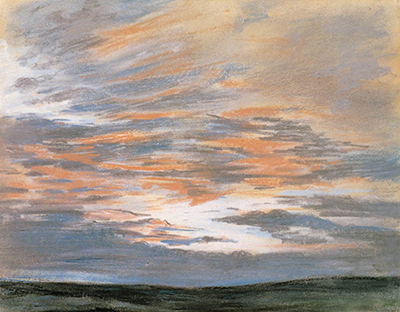Eugene Delacroix is known to have been an influence upon the Impressionist movement, even though he was not involved in landscape art particularly often. What we find in front of us here is a simple but beautiful study of a sky during sunset.
The bright red tones of this scene are instantly memorable and are also highly typical of Delacroix, who would use this colour in many of his most famous paintings. He deliberately focuses on the sky here, including only a minimal amount of land in order to study and perfect his skills on this topic. Whilst he had incredible natural abilities, he could only achieve what he did through the constant practice that he completed over many decades. Indeed, he never really stopped as he strived to find new genres and influences right throughout his career. The item that we find here feels distinctly romanticist and could easily have been found in the oeuvre of Constable or Turner, whose own landscape studies have also been published and analysed in great detail too. They would carry small notebooks around in order to complete simple watercolours and drawings whenever they were travelling around, normally of the countryside, but sometimes whilst in more suburban settings.
Our artist here was also interested in the UK, but his landscapes were based in his native France. The likes of Monet would have seen these and felt a greater urge to concentrate on this genre, even though Delacroix only visited it on a few occasions. They also learnt from his use of colour which could easily be adapted into a wide range of content. Nature and wildness was a key concept within the Romanticist movement, and so it is perhaps surprising that Delacroix did not complete more landscape and seascape paintings, particularly considering the natural beauty of large parts of the French region. Perhaps it was the more traditional art forms that he felt he wanted to concentrate on, with history painting being more closely matched to the old masters that he had followed from a young age, such as Rubens and also Titian.
This piece has been estimated at around 1849, most likely due to the recorded movements of the artist. It was completed using pastels, which he incorporated into drawings over a number of decades, right up until a year before his death. It can now be found in the Louvre, an institution which perhaps owns more of his art than anyone else. They also have a particularly comprehensive collection of drawings from right across his career. Academics have long discussed a period of around ten years where Delacroix was using light and colour in a way that the Impressionists would later become much more famous.




